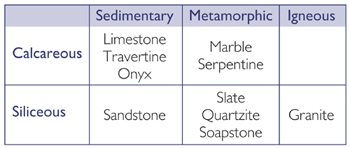-
4225 Florence Blvd
-
Appointments Recommended
Mon - Fri: 8:00am - 4:00pm
-
Schedule Your Appointment:
(402) 451-3400 - Request Quote
Mon - Fri: 8:00am - 4:00pm
GET TO KNOW YOUR STONE
The first step in proper stone care and maintenance is to understand your stone's geological classification and composition. this information will help you to identify what cleaning products to use and how best to care for your natural stone.
Natural stone is categorized into three basic geological classifications by their respective formation processes: Sedimentary, Metamorphic and igneous. Additionally, stones in each category can be either Calcareous or Siliceous.
Calcareous stone is composed mainly of calcium carbonate, a chemical compound commonly found in natural stone, shells and pearls. Calcium Carbonate is sensitive to acidic solutions so mild, non-acidic cleaners are recommended.
Siliceous stone, as the term implies, is one composed primarily of silicates, such as quartz, feldspar, mica, etc. as such, a siliceous stone is generally resistant to most acids found in kitchen settings, although acidic cleaners are still not recommended, as these stones may contain trace levels of minerals that are acid sensitive.
The following chart will be a helpful guide:

EASY CARE TIPS
To get the longest life and preserve the beauty of your natural stone, follow these simple tips:
Coasters
Use coasters under all glasses, particularly those containing alcohol or citrus juices.
Trivets
While many stones can withstand heat, the use of trivets or mats is recommended.
Dust Mopping
Dust mop interior floors frequently using a clean non-treated dry dust mop. Sand, dirt and grit are abrasive and can damage natural stone.
Mats/Rugs
Mats or area rugs inside and outside an entrance will help to minimize the sand, dirt and grit that may scratch the stone floor. Be sure that the underside of the mat or rug is a slip resistant surface.
Vacuum Cleaners
If used, be sure the metal or plastic attachments or the wheels are not worn as they can scratch the surface of some stones.
Spills
Blot the spill with a paper towel immediately. Don't wipe the area, it will spread the spill. Flush the area with water and mild soap and rinse several times. Dry the area thoroughly with a soft cloth. Repeat as necessary.
CLEANING
CLEANING PRODUCTS
 SEALING
SEALING
Sealing is a common step taken on some stones as an extra precaution against staining. In fact, the sealing products used in the stone industry are "impregnators" which do not actually seal the stone, but more correctly act as a repellent rather than a sealer. Sealing does not make the stone stain proof, rather it makes the stone more stain resistant. When consulting with your stone supplier, you may find that many stones do not require sealing. However, applying an impregnating sealer is a common practice.
When considering sealing, remember that sealing the stone does not make the stone stain proof, it makes it more resistant to staining.
If a sealer is applied in a food preparation area, be sure that it is non-toxic and safe for use.
Consult with your supplier or sealing manufacturer specific to the type of sealer and frequency of use recommended.
 STAIN IDENTIFICATION TIPS
STAIN IDENTIFICATION TIPS
Identifying the type of stain on the stone surface is the key to removing it. Stains can be oil based, organic, metallic, biological, ink based, paint based, acid based. If you don't know what caused the stain, consider likely staining agents that may have been present. Here are some questions you consider:
STAIN REMOVAL STEPS
Surface stains can often be removed by cleaning with an appropriate cleaning product or household chemical.
WHAT TYPE OF STAIN IS IT?
The following sections describe the types of stains you may have to deal with and the appropriate household chemicals to use and how to prepare and apply a poultice to remove the stain.
Oil-based
(grease, plumbers' putty, tar, cooking oil, milk, cosmetics)
An oil-based stain will darken the stone and normally must be chemically dissolved so the source of the stain can be flushed or rinsed away. Clean gently with a soft, liquid cleanser with one of the following: household detergent, mineral spirits, or acetone.
Organic
(coffee, tea, wine, fruit, tobacco, paper, food, urine, leaves, bark, bird droppings)
May cause a pinkish-brown stain and may disappear after the source of the stain has been removed. Outdoors, with the sources removed, sun and rain action will generally bleach out the stains. Indoors, clean with 12% hydrogen peroxide (hair bleaching strength) and a few drops of ammonia.
Metal
(iron, rust, copper, bronze)
Iron or rust stains are orange to brown in color and follow the shape of the staining object such as nails, bolts, screws, cans, flower pots, metal furniture. Copper and bronze stains appear as green or muddy-brown and result from the action of moisture on nearby or embedded bronze, copper or brass items. Metal stains must be removed with a poultice. (See website on Using a Poultice – www.marble-institute.com/consumers/poultices/. Deep-seated, rusty stains are extremely difficult to remove and the stone may be permanently stained.
Biological
(algae, mildew, lichens, moss, fungi)
Clean with diluted cleaning solution. Use a 1/2 cup of any of the following: ammonia, bleach, or hydrogen peroxide and a gallon of water. Reminder: do not mix bleach and ammonia.
Ink
(magic marker, pen, ink)
On light colored stones, clean with bleach or hydrogen peroxide. On dark colored stones, clean with lacquer thinner or acetone.
Paint
Small amounts can be removed with lacquer thinner or scraped off carefully with a razor blade. Heavy paint coverage should be removed only with a commercial "heavy liquid" paint stripper available from hardware stores and paint centers. These strippers normally contain caustic soda or lye. Do not use acids or flame tools to strip paint from stone. Paint strippers can etch the surface of the stone; repolishing may be necessary. Follow the manufacturer's directions for use of these products, and flush the area thoroughly with clean water. Protect yourself with rubber gloves and eye protection, and work in a well-ventilated area. Use only wood or plastic scrapers for removing the sludge and curdled paint. Normally, latex and acrylic paints will not cause staining. Oil-based paints, linseed oil, putty, caulks and sealants may cause oily stains. Refer to the section on oil-based stains.
Water Spots & Rings
(surface accumulation of hard water)
Buff with dry 0000 steel wool.
Fire & Smoke Damage
Older stones and smoke or fire-stained fireplaces may require a thorough cleaning. When the smoke is removed, there may also be some etching (due to carbonic & other acids in smoke). Commercially available "smoke removers" may save time and effort.
Etch Marks
(caused by acids left on the surface of the stone)
Some materials will etch the finish but not leave a stain. Others will both etch and stain. Contact your stone dealer or call a professional stone restorer for refinishing or repolishing etched areas.
Efflorescence
(a white powder that may appear on the surface of the stone)
It is caused by the deposition of mineral salts carried by water from below the surface of the stone. When the water evaporates, it leaves the powdery substance. If the installation is new, dust mop or vacuum the powder. You may have to do this several times as the stone dries out. Do not use water to remove the powder; it will only temporarily disappear. If the problem persists, contact your installer to help identify and remove the cause of the moisture.
Scratches & Nicks
Slight surface scratches may be buffed with dry 0000 steel wool. Deeper scratches and nicks in the surface of the stone should be repaired and repolished by a professional.
Using a Poultice
Go to www.marble-institute.com/consumers/poultices/ for more information, or call a stone professional (recommended).
Natural Stone Easy to Clean and Maintain!
Call your professional stone supplier, installer or a restoration specialist for problems that appear too difficult to handle.